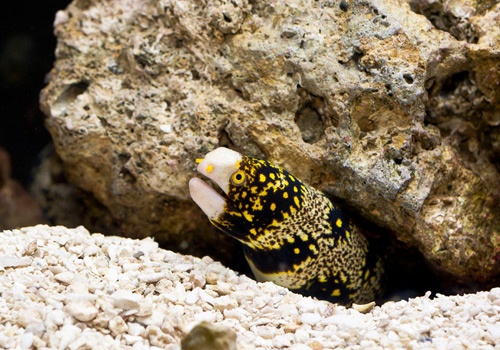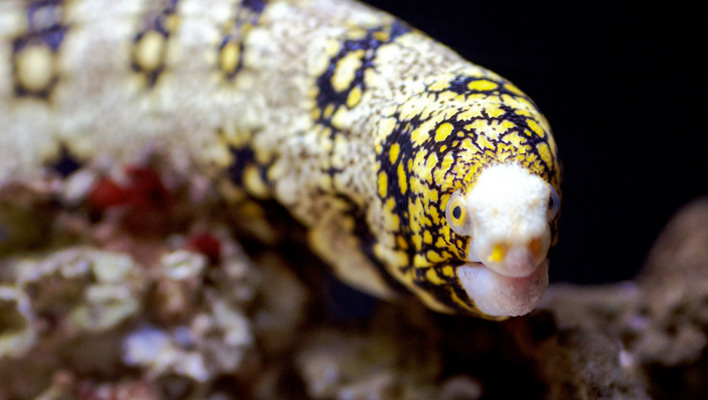That’s the point I tried to communicate to my wife, Melissa, when developing the livestock list for the 125-gallon FOWLR (fish-only-with-live-rock) tank that now resides in our living room.
I really wanted to include a snowflake moray (Echidna nebulosa), a denizen of the Indo-Pacific, in my lineup of fishes, and I was launching into a well-rehearsed sales pitch, knowing I had my work cut out for me trying to sell the idea of an eel to my somewhat ophidiophobic spouse.
Then I made a cosmic blunder: Just when I thought I had her convinced, I offhandedly remarked, “And don’t worry, I’ll keep the tank well covered so it’ll never escape.”
Thus ended my dream of adding E. nebulosa to my tank. No way was a snake-shaped fish with the ability to depart its aquarium ever going to cross the threshold of our home, Melissa informed me in no uncertain terms.
However, while it’s too late for me, there’s no reason my fellow salties should be denied the pleasure of keeping what is arguably the ideal aquarium moray. So let’s take a look at some of E. nebulosa’s prime selling points:
1. Endearing beauty
With white, yellow, and brown blotched markings on its body, vaguely reminiscent of snowflakes, and an almost cute face with gold-rimmed eyes, E. nebulosa is quite visually stunning—some (though not my wife) would even say “charming.”
2. Just the right size
Many of the moray eels can get downright massive! For example, the very common green moray of the western Atlantic (Gymnothorax funebris) can grow to about 8 feet in total length, and the aptly named Indo-Pacific giant moray (Gymnothorax javanicus) can reach almost 10 feet. Obviously, these morays grow too large for virtually any home aquarium.
E. nebulosa, on the other hand, reaches only a very manageable 3 feet, and most specimens remain considerably smaller. While 2 to 3 feet is definitely a respectable size for an aquarium fish, a standard 55-gallon aquarium will suffice as minimum housing for this species.
3. Fish friendly (more or less)
With a penchant for eating crustaceans more so than fish, E. nebulosa will generally cohabit with other fish species with few problems. Nonetheless, I wouldn’t rule out the possibility that bite-size fish may be taken, especially when the eel starts to gain some size. So, just to be on the safe side, I would recommend avoiding housing a snowflake moray with any fish small enough to be swallowed. Of course, cleaner shrimps and other ornamental crustaceans are right out as tankmates, as well.
4. Generally easy to feed
Though the occasional specimen may require live foods, such as glass shrimp, to initiate a feeding response, most snowflake morays will readily adapt to non-living fare. Offer a variety of fresh or frozen (and occasionally vitamin-enriched) meaty items of marine origin, such as shrimp, squid, clams, mussels, and fish flesh, ideally presented with tongs or a feeding stick (never with your hands). Snowflake morays should be fed only two or three times per week.
Potential drawbacks
 While I’ve painted a justifiably positive picture of E. nebulosa, this species does have a few potential drawbacks to consider. One is its ability to undermine and topple rockwork. You do want to provide a good amount of live rock for the eel to hide in, but be sure any stacked rock is carefully secured, e.g., with plastic tie-wraps (zip ties) or aquarium-safe epoxy, so the eel can’t topple it with its wriggling.
While I’ve painted a justifiably positive picture of E. nebulosa, this species does have a few potential drawbacks to consider. One is its ability to undermine and topple rockwork. You do want to provide a good amount of live rock for the eel to hide in, but be sure any stacked rock is carefully secured, e.g., with plastic tie-wraps (zip ties) or aquarium-safe epoxy, so the eel can’t topple it with its wriggling.
Then there’s the issue of the eel potentially escaping and winding up on the floor—which is what killed my chances of owning one. This is a very real concern, as E. nebulosa is an accomplished escape artist and will slither out of any opening large enough to allow its passage. So, cover the tank well!
Are you sold?
Hopefully I’ve done a better job of convincing you of E. nebulosa’s aquarium-worthiness than I did with my wife. Now, if you can think of anything I can say to change her mind, please let me know. It still feels like something’s missing from my tank!




I own a black edge moray eel and a yellow head moray eel. Both have never tried escaping; what I would tell your wife is well fed eels do not escape or hurt tank mates if they are on a proper feeding schedule. They are den animals but my yellow head moray is very active, the black edge moray just hides in his hole. If you do get one which I hope you do they are a marvel to look at and are the most misunderstood animal in the ocean aside from sharks. Lovely article cheers.
I’ve my snowflake eel on 2013 from size of 15″ growing till now at size 28″. It peaceful characteristic no bother small fish such as percula clown & damsel. It very awesome and entertained when swim around all the time especially able to recognized owner.
Well interactive and attractive eel ! Gem of my tank!
It’s great to hear your snowflake is doing so well and bringing you lots of joy, Jackie. Thanks!
Excellent commentary on the snowflake.
I have kept a few different species of eel, although never able to reproduce captive, I have held snowflake ghost moray, blue ribbon. Love electric if you have one you need to donate.
Thanks for your kind comment and insights, Curtisio!
I kept my Snowflake in a 350 gallon setup. he was one of 3 Eels i had along with a Zebra and a Chainlink. the interaction between them was fascinating to watch especially at feeding time.
Sounds like a really cool system, Graham! Needless to say, I’m totally envious!
I agree with Jeff. I’d love to see some pictures of your eels and setup, Graham!
I have housed my eel with two cleaner shrimp. It never bothers them. Even opens its mouth to let them clean.
That’s great to hear, Aaron. Hopefully the eel will continue to behave itself around those shrimp so you can enjoy their cleaning activity for a long time to come.
I kept a snowflake in a 90 gallon for over 8 years. He was a great pet. Would actually come up and eat from my fingers (not that I am recommending that). He never did try to escape, although he did pull the grate off the intake of a canister filter and got stuck on the tube, but luckily I caught it quick… so make sure all intakes and power heads are well secured.
Great advice, Kevin! Sounds like a little “eel-proofing” is a must if you want to keep these guys out of trouble in your tank.
You guys are aware that moray eels are hermaphrodites right? Many of them change sex. So referring to them as male or female is difficult.
A species on my “must try” list!
If you do end up trying one, let us know how it goes. Thanks Matt!